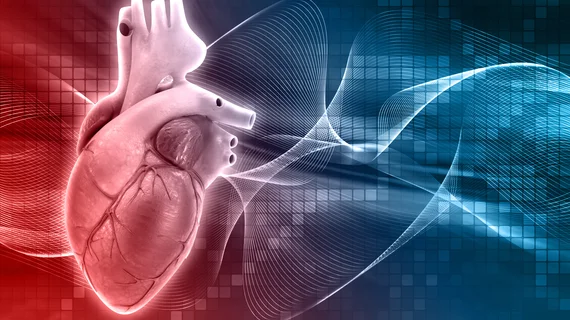OHCA protocol with angiography, therapeutic cooling slashes mortality rates
A strict protocol mandating coronary angiography and therapeutic hypothermia contributed to “startling” improvements in survival rates for out-of-hospital cardiac arrest (OHCA), researchers reported in JACC: Cardiovascular Interventions.
The results suggest adhering to this strategy can slash mortality rates, even in patients similar to those in the TTM trial, which raised “severe uncertainty about the efficacy of and need for therapeutic hypothermia,” reported authors from Hannover Medical School in Hannover, Germany, led by Muharrem Akin, MD.
Researchers enrolled 233 consecutive OHCA patients admitted to a single hospital who were treated according to the Hannover Cooling Registry (HACORE) protocol. The process involved CT imaging, coronary angiography and revascularization, hemodynamic support for cardiogenic shock and mandatory therapeutic hypothermia to a target of 32 Celsius for 24 hours, followed by a 72-hour rewarming period to normal temperature.
Thirty-day mortality was 37 percent overall but dropped to 27 percent in patients who matched the inclusion criteria of the TTM trial—significantly lower than the 44 percent reported in that study.
“It must be acknowledged that a single-center observational registry is neither designed nor powered to test whether hypothermia is superior to controlled normothermia,” Akin and coauthors wrote. “However, it demonstrates that a defined protocol aiming at optimal and evidence-based post-CPR management including therapeutic hypothermia and routine invasive assessment may result in lower mortality rates.”
Seventy-three percent of the patients in the study had ventricular fibrillation, while 20 percent had asystole and 8 percent had other rhythms.
“Of note, this cohort included 40% of patients with cardiogenic shock, whereas the equivalent subgroup in the TTM trial consisted only of 15%,” the authors wrote.
Commenting in a related editorial, Michael Mooney, MD, said this study has important implications in America, where an estimated 300,000 OHCAs occur annually with reported survival rates between 6 and 9 percent.
“This provocative report blended many of the most powerful approaches to cardiac arrest care together and reported startling outcomes,” wrote Mooney, with the Minneapolis Heart Institute Foundation.
Mooney said the relatively high rates of bystander CPR (62 percent) and witnessed cardiac arrest (81 percent) likely contributed to the good results. Also, he would have preferred to see more neurological outcomes reported, as survival alone is typically considered less important than survival with a good neurological outcome.
Nevertheless, Mooney agreed with the HACORE investigators that early angiography should be the default approach in treating both OHCA and ST-segment elevation myocardial infarction. This could improve “the sluggish adoption of (therapeutic hypothermia) and advanced therapies” for OHCA, he suggested.
“It is my belief that a complete integration of cardiac arrest care into existing ST-segment elevation myocardial infarction networks is the most promising method to address the sustained cardiac arrest health care crisis and that a consensus best practice protocol would look quite similar to HACORE,” Mooney wrote.

